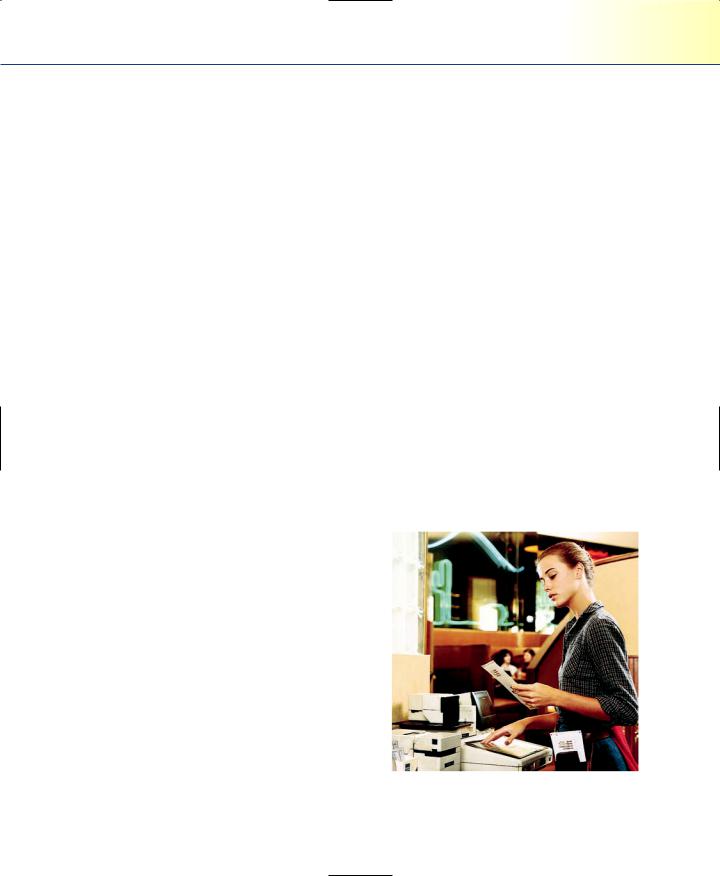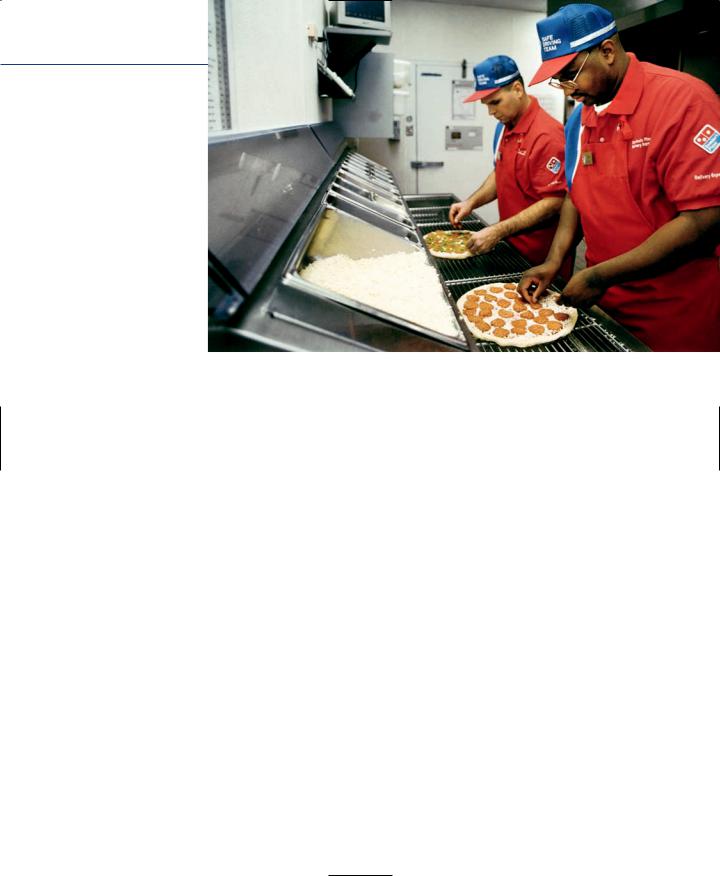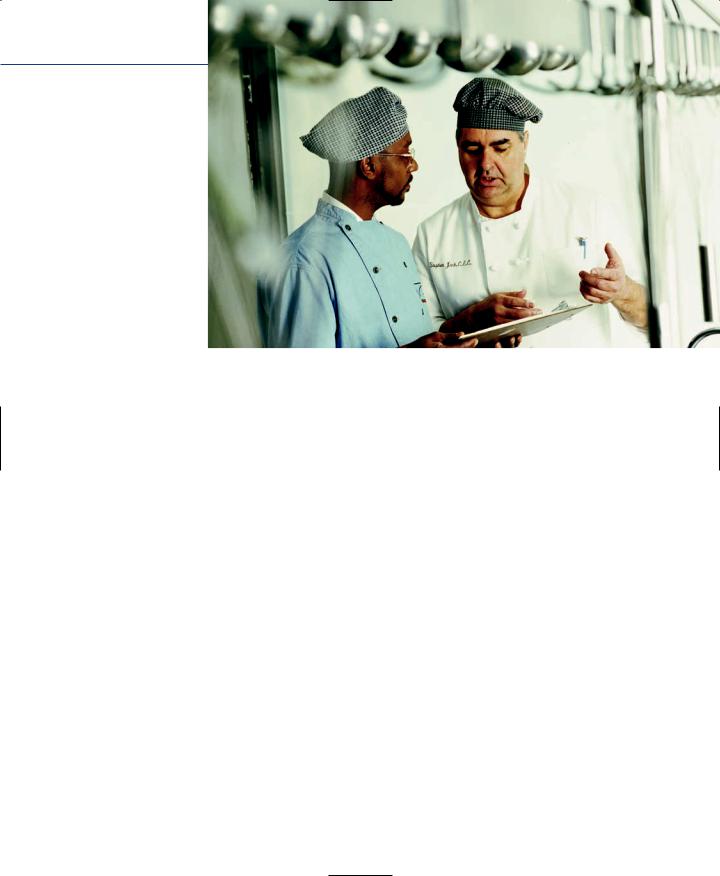
- •CONTENTS
- •PREFACE
- •Content—Benefits for Students
- •Content—Benefits for Instructors
- •Features of the Book for Students and Instructors
- •Supplementary Materials
- •Acknowledgments
- •What Is Hospitality Management?
- •The Manager’s Role in the Hospitality Industry
- •Why Study in a Hospitality Management Program?
- •Planning a Career
- •Employment as an Important Part of Your Education
- •Getting a Job
- •Employment at Graduation
- •The Outlook for Hospitality
- •Summary
- •Managing Change
- •Demand
- •Supply
- •Workforce Diversity
- •The Impact of Labor Scarcity
- •Summary
- •The Varied Field of Food Service
- •The Restaurant Business
- •The Dining Market and the Eating Market
- •Contemporary Popular-Priced Restaurants
- •Restaurants as Part of a Larger Business
- •Summary
- •Restaurant Operations
- •Making a Profit in Food Service Operations
- •Life in the Restaurant Business
- •Summary
- •Chain Restaurant Systems
- •Independent Restaurants
- •Franchised Restaurants
- •Summary
- •Competitive Conditions in Food Service
- •The Marketing Mix
- •Competition with Other Industries
- •Summary
- •Self-Operated Facilities
- •Managed-Services Companies
- •Business and Industry Food Service
- •College and University Food Service
- •Health Care Food Service
- •School and Community Food Service
- •Other Segments
- •Vending
- •Summary
- •Consumer Concerns
- •Food Service and the Environment
- •Technology
- •Summary
- •The Evolution of Lodging
- •Classifications of Hotel Properties
- •Types of Travelers
- •Anticipating Guest Needs in Providing Hospitality Service
- •Service, Service, Service
- •Summary
- •Major Functional Departments
- •The Rooms Side of the House
- •Hotel Food and Beverage Operations
- •Staff and Support Departments
- •Income and Expense Patterns and Control
- •Entry Ports and Careers
- •Summary
- •The Economics of the Hotel Business
- •Dimensions of the Hotel Investment Decision
- •Summary
- •The Conditions of Competition
- •The Marketing Mix in Lodging
- •Product in a Segmented Market
- •Price and Pricing Tactics
- •Place—and Places
- •Promotion: Marketing Communication
- •Summary
- •The Importance of Tourism
- •Travel Trends
- •The Economic Significance of Tourism
- •The United States as an International Tourist Attraction
- •Businesses Serving the Traveler
- •Noneconomic Effects of Tourism
- •Summary
- •Motives and Destinations
- •Mass-Market Tourism
- •Planned Play Environments
- •Casinos and Gaming
- •Urban Entertainment Centers
- •Temporary Attractions: Fairs and Festivals
- •Natural Environments
- •On a Lighter Note. . .
- •Summary
- •Management and Supervision
- •The Economizing Society
- •The Managerial Revolution
- •Management: A Dynamic Force in a Changing Industry
- •What Is Management?
- •Summary
- •Why Study Planning?
- •Planning in Organizations
- •Goal Setting
- •Planning in Operations
- •The Individual Worker as Planner
- •Long-Range Planning Tools
- •Summary
- •Authority: The Cement of Organizations
- •Departmentalization
- •Line and Staff
- •Issues in Organizing
- •Summary
- •Issues in Human-Resources Management
- •Fitting People to Jobs
- •Recruiting
- •Selection and Employment
- •Training
- •Retaining Employees
- •Staff Planning
- •Summary
- •The Importance of Control
- •Control and the “Cybernetic Loop”
- •Tools for Control
- •Summary
- •Leadership as Viewed by Social Scientists
- •Why People Follow
- •Leadership Theories
- •Communication
- •The Elements of Leading and Directing
- •Developing Your Own Leadership Style
- •Summary
- •A Study of Service
- •Rendering Personal Service
- •Managing the Service Transaction
- •How Companies Organize for Service
- •Summary
- •INDEX

102 |
Chapter 4 Restaurant Operations |
Restaurant Operations
CAREERS IN HOSPITALITYQ
The best way to become familiar with operations in a restaurant or other food service organization is to work in one. The following discussion, however, should give you useful background and a framework for thinking about your experiences. We will focus on three areas of the restaurant: the front of the house, the back of the house, and the “office.” Within each section, we will look at the principal responsibilities of each area, the tasks that are performed there, and the kinds of roles played in the food service drama by employees working in that area. Finally, we will look at
the general supervisory and managerial positions typical of that area.
Because our concern is with the whole range of restaurants, from QSR to fine dining, the amount of detail we can deal with will be limited. In general, we’ll take as our model a medium-priced, casual table service restaurant. Where there are substantial variations in quick service or fine dining, we’ll note those, however.
THE FRONT OF THE HOUSE
This is the part of the operation with which everyone is familiar because they can see it. It is more complex, however, than it appears at first. The front of the house is at once an operating system, a business place, and a social stage setting. As an operating system, it is laid out to provide maximum efficiency to workers and ease of movement to guests. As a business, it is a marketplace that provides an exchange of service for money, which requires appropriate controls. Finally, it is a social place where people not only enjoy their meals but enjoy one another’s company, good service, and a pleasing atmosphere.
Responsibilities. The key responsibility of the front of the house is guest satisfaction, with particular emphasis on personal service. The chapter “The Role of Service in the Hospitality Industry” discusses service in more detail, but here we will note that service goes beyond the mechanical delivery of the food to include the way the guest is served by the people in the restaurant.
The kind of service that should be delivered has a great deal to do with what the guest wants and expects. In a quick-service restaurant, for example, guests expect economy and speedy service at the counter and self-service—even to the point of discarding their own used disposables after they are finished eating. Although there is emphasis on speed and economy, the guest is still entitled to expect a friendly greeting, accuracy in order filling, and a cheerful willingness to handle any problems that

Restaurant Operations |
103 |
occur. In midscale restaurants, the table service provided raises the level of interaction with the guest. Although speed of service is still usually expected, the success of the guest’s experience is more dependent on the server’s personal style. A grouchy server can ruin a good meal, while a pleasant disposition can help immensely when things do go wrong.
In casual, casual upscale, and fine dining, guest satisfaction and service requirements have a considerably different frame of reference. As a rule, casual dining implies a leisurely meal, and that is even more true for fine dining. Accordingly, speed is not always as important as the timely arrival of courses, that is, when the guest is ready. The higher price the guest pays raises the level of service he or she expects. A server in a coffee shop may serve from the improper side or ask “who gets which sandwich” without arousing a strong reaction. Errors should not happen there, either, but when the price is modest, guests’ expectations are usually modest. On the other hand, when people are paying more for a meal, they expect professional service and a high degree of expertise on the part of the staff.
Although service provision is the most obvious job of the front of the house, those who work there share in the responsibility for a quality food product as well. This means that orders should be relayed accurately to the kitchen. This also means food shouldn’t be left to get cold (or baked dry under heat lamps) at a kitchen pickup station. If there is an error in the way food is prepared, the front of the house is where it is likely to show up in a guest complaint. People in the front of the house, therefore, need to be prepared to deal with complaints. This requires at least two things. First, there must be a willingness to listen sympathetically to a guest’s complaint. Second, a system must be in place that permits the server or a supervisor to correct any error promptly and cheerfully. In other words, employees must be empowered to satisfy guests’ needs. (Empowerment, which is discussed in the final chapter of the book, refers to an approach to managing people that gives employees discretion over as many decisions as possible affecting the quality of the guest’s experience.) Because customers represent potential future sales and powerful word-of-mouth advertising, an unhappy guest is much more expensive than a lost meal.
The front of the house is also the place where the exchange of goods and services takes place. As a result, a lot of money changes hands. Thus, the “control” aspects of the operation, such as check control, credit card control, and cash control, are very important. Guest check control—being sure that every order is recorded— prevents servers from “going into business for themselves.” An unscrupulous server might take orders, serve the food, and pocket some or all of the money. Today, point-of- sale systems make this kind of scam much more difficult, but there are still ways around even the most scientific system. Because money is the most valuable commodity, ounce

104Chapter 4 Restaurant Operations
for ounce, that a person can steal, extreme vigilance is called for in controlling cash. Further, servers must take responsibility for securing payment for meals served, on behalf of the restaurant. Everything that is ordered by customers must be bought and paid for, or at least accounted for.
Tasks. From the preceding description of responsibilities, you can see the kinds of tasks performed in the front of the house:
■Greeting the guest
■Taking the order
■Serving the food
■Removing used tableware
■Accepting payment and accounting for sales, charge as well as cash
■Thanking the guest and inviting comments and return business
Roles. The tasks are performed quite differently in different levels of restaurants. The hostess or host (in more upscale operations, the headwaiter or waitress or maître d’hôtel) greets the guests, shows them to their table, and, often, supervises the service. Some large, very busy restaurants separate greeting and seating, with hostesses or hosts from several dining rooms (seaters) taking guests to their table after the guests have been directed to them by the person at the main entrance, sometimes called the greeter. At the opposite end of the scale, in QSRs, the counter person is the greeter/order-taker and change-maker, thus making the smile and personal greeting there more important than casual observation might suggest.
The cashier’s main duty is taking money or charge slips from guests and giving change when the check is paid. In some smaller operations, however, the cashier doubles as a host or hostess. The cashier is also sometimes responsible for taking reservations and making a record of them. Having a separate cashier to perform this function is one of the original “controls” evident in the restaurant industry. By separating the cash function, accountability is placed solely on one person.
In table service operations, the food server takes the order and looks after the guest’s needs for the balance of the meal. The server is the person who spends more time with the guest than any other employee. What the guest expects regarding service is based on the type of operation. More elaborate service, potentially longer interactions with the server, and highly considerate behavior on the part of the server are all expected in more expensive operations. In family restaurants and quick-service operations, although the length and intensity of interaction are much lower, the guest is entitled to certain minimum—and reasonable—expectations: a genuine interest in the

Restaurant Operations |
105 |
customers on the part of the server, a friendly and cheerful manner, and competence in serving the right food promptly. At all levels of restaurant service, excellent service is crucial to success in an increasingly competitive market.
Servers are generally assigned to a specific group of tables, called a station. In some restaurants, servers work in teams to cover a larger station, often with the understanding that only one of them will be in the kitchen at a time so that at least one of them will be in the dining room and available to the guests at all times. In European dining rooms and those in North America patterned after them, a chef de rang and commis de rang—effectively, the chief of station and his or her assistant—work together in a team. In less formal operations, food servers are supported by a busperson who clears and sets tables but provides no service directly to the guest, except perhaps to pour water or coffee. The busperson’s job is basically to heighten the productivity of the service staff and to speed table turnover and service to the guest. Their personal appearance and manner, however, are a part of the guest’s experience. (Many operations fall somewhere in between the two extremes and use different types of service teams.)
Supervision. Front-of-the-house supervision is ideally exercised by the senior manager on duty. The importance of having a management presence cannot be overstated. It is important from the view of employees and customers, and it also provides greater confidence to the customers. Most managers should be expected to devote the majority of their time to the front of the house during meal hours to ensure that guests are served well (although adequate attention must also be paid to the back of the house). This enables
the manager to greet and speak with guests. In this sense, the manager is expected to be a public figure whose recognition is important to the guest— “I know the manager here.” At the same time, she or he can deal with complaints, follow up on employee training, and generally assess the quality of the operation. In some cases, of course, the manager finds it necessary to spend more time in the back of the house.
In larger operations, a dining room manager is delegated responsibility from the general manager to manage service in a specific area or in the

106Chapter 4 Restaurant Operations
whole front of the house. In many operations, the job of host or hostess includes supervisory responsibility for the service in the room or rooms for which he or she is responsible.
In addition to supervising service, managers in the front of the house have responsibility for supervising cleaning staff and cashiers, and for opening and closing procedures in the restaurant. Opening and closing duties are sometimes discharged by a lead employee.
THE BACK OF THE HOUSE
In many ways, the back of the house is like a factory, of which there may be two varieties. Some factories are virtually assembly plants. Others manufacture goods from raw materials. A similar distinction can be made regarding restaurants. Some are really an assembly operation, where food is simply finished and plated by kitchen staff. This is true of operations that use a lot of prepared foods such as portioned steaks or a sandwich operation such as a QSR. In others, the product is actually manufactured on the premises or, as we more commonly say, cooked from scratch.
Responsibilities. The principal responsibility of the back of the house is the quality of the food the guest is served. This is a matter not only of food taste; food safety, sanitation, food cost control, management of supplies, and so on are also significant responsibilities of the back of the house. Because prompt, timely service is dependent on being able to get the food out of the kitchen on time, the kitchen also has a major responsibility with regard to service.
Tasks. Food production stands out as the predominant work done in the back of the house. Controlling quality and cost are usually parallel activities. In other words, standardized recipes and carefully thought-out procedures, used consistently, will produce food that has the correct ingredients, thus ensuring both quality and cost.
An important dimension of cost control is portion control. Say a sandwich that calls for 2 ounces of ham has 2 1⁄2 ounces. Although the portion may be “only” 1⁄2 ounce overweight, that is 25 percent additional meat and probably represents an increase of 20 percent in cost. Portion control has a quality dimension as well. Assume two guests order fish and the planned portion is 8 ounces. One receives a 7-ounce portion and the other 9 ounces. Although the average is the same and so cost won’t be affected, the guests are likely to notice the discrepancy. Portions should be the same for a guest at every visit—and they should be the same for every guest. Needless to say, controlling costs has a direct impact on the profitability of a restaurant.

Quality control is important in all types of food service operations. (Courtesy of Domino’s Pizza, Inc.)
Dishwashing and pot washing are not skilled jobs, but they are certainly important work. Anyone who has been in a restaurant that ran out of clean dishes in the middle of the meal or pots during a heavy preparation period can testify to this. These are activities that use a significant amount of labor in any operation that serves food on permanent ware and has a varied menu (i.e., most operations outside of quick service). Labor cost control is, therefore, an important element in planning ware washing. Because detergent is a commodity that restaurants use in large quantity, the cost of supplies is a significant concern. Quality work, which relates not only to the workers’ performance but also to adequate water temperatures and soap solutions, is absolutely essential.
Cleanup work is important in both the front and back of the house, but because it is more clearly related to sanitation, back-of-the-house cleanup is especially significant. Although in most operations workers clean up as they go during the day, the heavy cleanup is usually done at night, when the restaurant is closed.
Roles. Cooks and chefs come not only in all sizes and shapes but also with varying skill levels. In fine dining, cooking is generally done by people with professional chef’s credentials, received only after serving a lengthy apprenticeship or a combination of formal education and on-the-job experience. The much-talked-about “hamburger flippers” of quick-service operations are at the other end of the scale. It is not surprising that the work that this group performs can be learned quickly, because the operation
107

108Chapter 4 Restaurant Operations
has been deliberately designed to reduce the skill requirements. In between these extremes lie the short-order cook, the grill person, the salad preparation person, and many others who have a significant amount of skill but in a narrow range of specialized activities. Whatever the skill level, it is crucial to the success of the operation that this work is done well.
Dishwashers are often people who have taken the job on a short-term—and often part-time—basis. Because the job is repetitive, monotonous, and messy, it is not surprising that it has a high turnover. We ought to note, however, that an inquisitive, observant person working in the dish room—or on the pot sink—is in a position to learn a lot about what makes a restaurant run. Many successful restaurant operators (and college and university professors) got their start in this position.
Some operations employ people with disabilities in dish and pot work as well as in salad and vegetable preparation. Mentally handicapped employees often find the routine, repetitive nature of the work suited to their abilities. Not surprisingly, they find that their dignity as individuals is enhanced by their success in doing an important job well. As a result, employers such as Marriott, which has developed successful programs for disabled workers, have experienced a significantly lower turnover among this group of workers.
An important role we haven’t touched on yet is that of the person (or persons) responsible for receiving the shipments of food at the back door as they are delivered. It is the receiver’s responsibility to accept shipments to the restaurant and to check them for accuracy in weight or count as well as quality.
In large operations such as hotels, resorts, and casinos, the receiver may report directly to the accounting department because the work relates to control. The receiver needs a good working relationship with the kitchen staff, whatever the formal reporting procedure. In most operations, the receiver has duties closely involved with kitchen operations, such as storing food and keeping storage and receiving areas clean and sanitary. Some restaurants distribute the tasks of the receiver among two or more people. In a hotel one of the authors ran, for instance, counting and weighing of goods received was done by the pot washer, whereas verifying quality was the responsibility of the restaurant manager on duty. Responsibilities vary greatly from operation to operation.
Food production is generally headed by a person carrying the title of chef, executive chef, or food production manager. In smaller, simpler operations, the title may be head cook or just cook. In these latter operations, the general manager and her or his assistants usually exercise some supervision over cooks, so it is important that they have cooking experience in their own backgrounds. In fact, one of the trends in casual dining has been to eliminate the position of chef and replace it with several cooks and a kitchen manager who is responsible for back-of-the-house administrative duties.

Restaurant Operations |
109 |
The role of chef continues to evolve. One association for a certain type of chef, a culinologist, is profiled in Industry Practice Note 4.1.
Closing (cleaning up, shutting down, and locking up) responsibility is very much related to these activities but deserves separate discussion because of its importance in relation to sanitation and security. The closing kitchen manager is responsible for the major cleanup of the food production areas each day (and probably has the same responsibility in the front of the house). This person also oversees putting valuable food and beverage products into secure storage at the end of the day and locking up the restaurant itself when all employees have left. The job is not a very glamorous one, but it is clearly important. In this day and age of security concerns, the position takes on added importance and responsibility.
THE “OFFICE”
We have put “office” in quotation marks because it has many organizational designations, from “manager’s office” to “accounting office.” The functions relate to the administrative coordination and accounting in the operation.
Responsibilities and Tasks. The office has as its first task administrative assistance to the general manager and his or her staff. The office staff handles correspondence, phone calls, and other office procedures. These activities, although routine, are essential to maintaining the image of the restaurant in the eyes of its public. Ideally, managers should not be bogged down in this time-consuming work. It is essential to have office staff to free managers to manage.
A second major area of responsibility is keeping the books. Often, the actual books of account are kept in some other place (a chain’s home office or an accountant’s office for an independent), but the preliminary processing of cashier’s deposits, preparation of payrolls, and approval of bills to be paid are all included in this function. Prompt payment of bills is very important to a restaurant’s good name in the community; so whether this is done in-house, at a home office, or by a local bookkeeping service, it deserves careful and prompt attention. Either on the premises or off, regular cost control reports must be prepared, usually including the statement of income and expenses (which is discussed later in this chapter).
Roles. The manager’s administrative assistant often functions as office manager. Independent operators commonly employ a bookkeeper or accountant fullor part-time or use an outside service. On the other hand, chains handle most accounting centrally. Often, the secretary or office manager is responsible for filling out forms that serve as the basis for the more formal reports.

INDUSTRY PRACTICE NOTE 4.1
Research Chefs Association
The Research Chefs Association (RCA) is an organization for professionals who are involved with food product development and have a specific interest in the future of food. Its mission is focused on the concept of Culinology®, which is “the blending of the culinary arts and food science.” The association was formed in 1996 by a group of food professionals interested in food, culinary arts, new product development, and food science. The association attempts to bring all of these dimensions together for practitioners, educators, and students. There are now approximately 2,000 members spread across the United States among various regions. The approximate breakdown of members by type is 42 percent chefs; 31 percent affiliates (food scientists and affiliated fields); 14 percent associates (sales fields); and 13 percent students. Many of the students are studying Culinology at one of the seven academic institutions offering academic programs in this area.
One of the ways that the RCA is able to accomplish its objectives is through education and professional development (and certification). RCA-approved Culinology degree programs are housed in such universities as Cal Poly Pomona, Clemson University, and the University of Massachusetts. The University of Massachusetts, which has a particularly renowned food science program, provides extensive information about Culinology as an academic area and offers it as a degree program. An excerpt from their Web site states:
Today, when consumers enter the grocery store they not only expect foods to be inexpensive and safe but also to have a wide variety of flavors and textures that are often inspired by ethnic food traditions and unique innovations. In addition, books such as On Food and Cooking: The Science and Lore of the Kitchen by Harold McGee and television shows like Good Eats starring Alton Brown, have been instrumental in expanding cooking beyond the traditional Culinary Arts into the world of Food Science. These developments have made Culinary Science one of the hottest areas of the Food and Food Service Industries. The Department of Food Science has developed a unique concentration in Culinology that has been recognized by the Research Chefs Association. This program combines culinary Arts and Food Science by accepting students with a 2-year culinary arts degree and providing them with a science-oriented framework that enables them to obtain a B.S. in Food Science from the University of Massachusetts in three years.
The great benefit of Culinary Science training is that it outweighs all the competition because it’s the best of both worlds. As a culinologist, one not only has the scientific understanding of food processing but also the much-valued understanding of culinary arts. Combined together, this opens a spectacular opportunity to work in the food industry. The passion of food shared by culinarians allows them, through their research and development, to impact the food culture: a great example is Chef Boyardee who started his career as a chef and with the help of technology brought canned pasta and sauce to where it is today.
110

The food science world is a unique industry offering a great working experience in its many kitchen-laboratories. Included in this environment are all the benefits of corporate America with endless opportunity for individual career advancement, and most of all, the satisfaction of a food lover’s passion of working in the kitchen.1
Besides formal education through their links with academic institutions, the RCA also does a lot of work in the area of professional development of its members. Certification programs that the association provides include Certified Research Chef (CRC) and Certified Culinary Scientist (CCS) credentials. Both certifications require that certain qualification standards be met before a candidate can sit for the exam. The standards include formal education and professional experience in both food service and product research and development. Dr. Jerald Chesser (a professor of hospitality management at Cal Poly Pomona) is the Chair of the Certification Commission for the RCA, which oversees the certification program and its standards.
The RCA is fulfilling its mission in several other ways as well, including quarterly newsletters, outreach, sponsoring student scholarships, hosting regional meetings, and hosting an annual conference and tradeshow.
Culinology is an expanding field as a result of the growing interest in food in today’s society, as well as the continued professionalization of the industry. Interest in food, food development, and Culinology cuts across industry segments to include suppliers, quick-service, casual dining, and others. Food companies, for instance, are allocating more money to research and development than ever before as commercialization within the industry grows. Some of the latest trends and developments in food-related products (all of which were covered at a recent RCA conference) include umami flavors, packaging technologies, astronaut food, sustainable agriculture, baking science, and hospital haute cuisine.
For students who are interested in combining their interests in food, culinary arts, and food science, a degree (or a career) in Culinology allows them to put these skills to work. Potential employers include food service companies, manufacturers, distributors and suppliers, research companies, and academic institutions.
1.University of Massachusetts Department of Food Science, Culinary Science program (http://www.umass.edu/foodsci/ culinaryscience.html).
Sources: Correspondence with the Research Chefs’ Association (www.culinology.org); University of Massachusetts Department of Food Science (http://www.umass.edu/foodsci/).
111

112Chapter 4 Restaurant Operations
Supervision. As noted previously, the person who supervises on-premise clerical work usually reports to the general manager, as does any in-house accountant. We should note, however, that there are many smaller operations whose low sales volume will not support clerical staff. In these cases, the clerical and accounting routines are usually handled by the managers themselves. In chains, particularly QSR chains, reporting systems have become highly automated. Here, most reports are prepared from routine entries made in the point-of-sale register and transmitted directly to the central accounting office automatically.
GENERAL MANAGEMENT
We should now add one additional category to our framework for observing a restaurant— the general managers and their assistants. It is essential that there be someone in charge whenever an operation is open. One possible schedule is as follows (for a full-service casual restaurant that is open for the lunch and dinner periods): An assistant manager comes in before the restaurant opens and oversees all the opening routines. These include turning on equipment, unlocking storage areas, and seeing to it that all of the crew has shown up and that all the necessary stations are covered. The general manager arrives in midmorning and stays at least through the evening meal rush. The closing manager arrives sometime in the afternoon and is usually the last person to leave, locking up for the night. Effective managers, and restaurant companies, often use checklists as reminders, which are a good way to document tasks. An operation with different hours of operation would have a different schedule in some of the details, but the essential functions identified here would all have to be covered in some way. The key point is that someone in the unit is in charge at all times.
In talking about management, we have really been describing management presence. We may not always see the title “manager” used, however. Many of the duties of management are carried out by supervisors. In quick-service (as well as smaller) restaurants, managers and their assistants are often supplemented by crew chiefs and lead employees. Whatever the title, the responsibility of managing these various tasks must be taken care of.
We have used the title “general manager” in this section but should note that this is a title used principally in larger operations. The function of overall direction, however, is the same even if the title used is “unit manager” or “store manager” or simply “manager.” Because the general manager can’t be present every hour of the day, her or his assistants, whatever their titles, stand in for the manager when she or he cannot be physically present. A key point is that managers act as a team to give direction to the unit, to maintain standards (quality and cost), and to secure the best possible experience for their guests.

The work of managers in food service puts a high priority on communication. (Courtesy of Sodexho.)
Daily Routine. As we have already mentioned, opening and closing a restaurant require specialized work. The highest levels of activity, of course, occur during the meal periods. Between the rush hours, a lot of routine work is accomplished. The following is a look at the major divisions of a restaurant’s day.
Opening. Somebody has to unlock the door. In a small operation, it may be a lead employee; in a large operation, it will probably be an assistant manager. As other employees arrive for work, storage areas and walk-ins must be unlocked. If a junior-level supervisor was in charge of closing the night before, it is especially important that the first manager on duty inspect the restaurant and especially the back of the house for cleanliness and sanitation. One additional note that must be added here: It seems that restaurants have recently become targets of robberies, particularly in large U.S. cities. As a result, many restaurant companies are and have been reevaluating their opening and closing procedures. One strategy used to increase safety in restaurants is changing opening and closing procedures to ensure the safety of restaurant employees; for instance, some restaurants are requiring that restaurants be opened and closed by pairs of managers instead of individuals. Other safety measures include installing cameras at entry points (including the loading dock).
In larger restaurants, a considerable amount of equipment has to be turned on. Sometimes this process is automated, but in other operations, equipment is turned on by hand, following a carefully planned schedule. One element of a utility’s charge relates to the amount of power used, but another relates to the peak demand level. If someone throws all the electrical panel switches, turning on air conditioners, lights,
113

114Chapter 4 Restaurant Operations
exhaust fans, ovens, and so forth all at once, this will create a costly, artificially high demand peak. Schedules to phase in electrical equipment over a longer period may be followed by the person who opens up to avoid this problem.
As noted earlier, it is important to be sure that all stations are covered, that is, that everybody is coming to work. If an employee calls in at 6:30 A.M. to say he or she can’t make it, or if somebody just doesn’t show up, appropriate steps must be taken to cover that position. This could mean calling the appropriate supervisor at home to let that person know of the problem. Alternatively, the opening manager might also handle it more directly by calling in someone who can cover the position (having an “on-call” person each day helps to alleviate this problem).
Before and after the rush. Much of the work done outside the meal period is routine. Probably the most important is “making your setup,” that is, preparing the food that will be needed during the next meal period. In a full-menu operation, this will likely involve roasting and baking meats, chopping lettuce and other salad ingredients, and performing other food preparation tasks. In more specialized operations, it may involve slicing prepared meats or simply transferring an appropriate amount of ready- to-use food from the walk-in to a working refrigerator. It is essential that safe food-han- dling procedures always be followed to prevent food contamination. In some QSRs, a key portion of the setup actually occurs just as the meal period is about to begin, when product is prepared and stored in the bin, ready for the rush that is about to commence. The key element in making the setup is to do as much as possible before the meal to be ready to serve customers promptly.
Sidework is another important activity done by servers on a regular schedule. Sidework includes such tasks as cleaning and filling salt and pepper shakers, cleaning the side stands, and, in many restaurants, some cleaning of the dining room itself. This is work that can’t be done during the rush of the meal hour. The front of the house has a sidework setup for every meal period, too. Side stands must be stocked with flatware, napkins, butter, sugar packets, or whatever guest and food supplies might be needed during the coming rush.
Other routine work, such as calling in orders, preparing cash deposits and reports on the previous day’s business, and preparing and posting work schedules, is tended to by management staff or under their supervision. It is important that this routine work be done during off-peak hours so that managers on duty can be available during rush hours to greet guests, supervise service, and help out if a worker gets stuck. When you see a manager moving through the dining room pouring coffee, that manager is (or should be) using that opportunity as a way of greeting guests, observing operations, and helping busy servers rather than covering a shortage in the service staff.
The meal periods. Not every meal is a rush in terms of the restaurant’s seating capacity. Employees are scheduled, however, to meet the levels of business, so there
